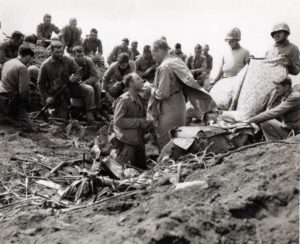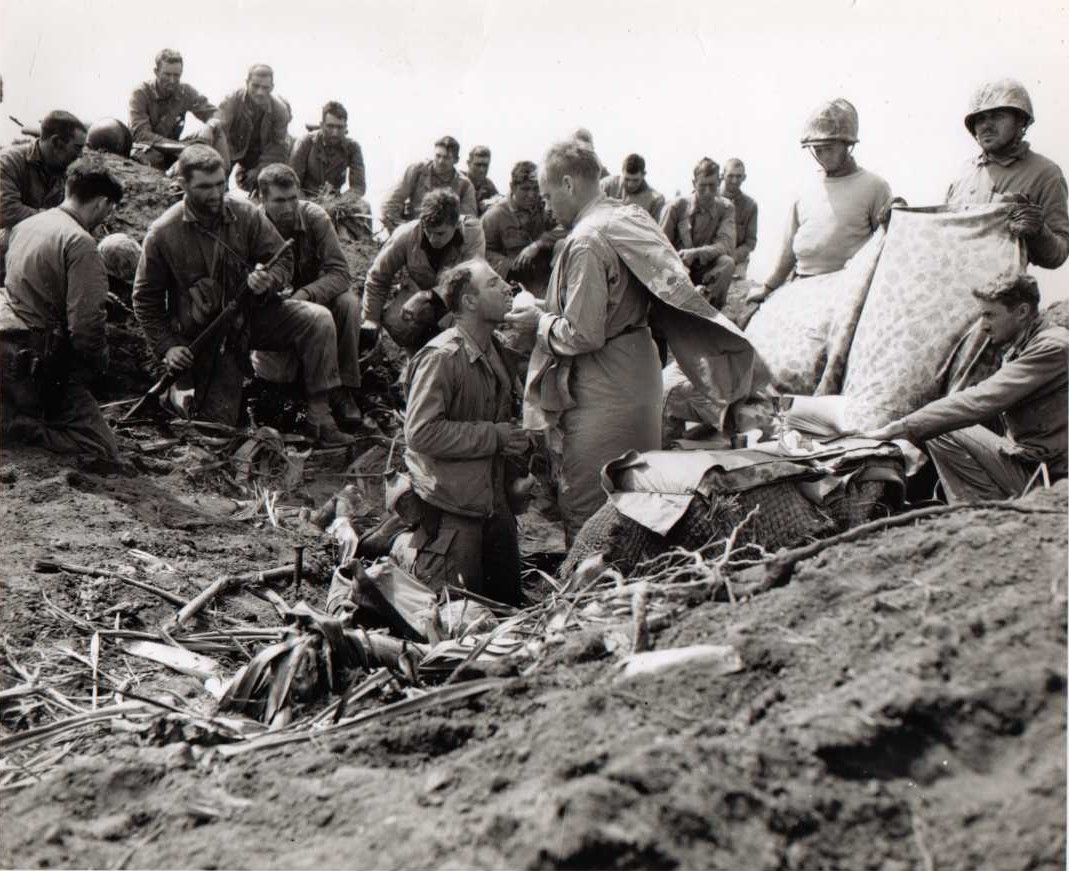
Central idea: The Holy Eucharist. Doctrine: The Real Presence of Christ in the Holy Eucharist. Practical application: Worthy reception of the Holy Eucharist.
To view Lectionary 168.
Central idea: The Holy Eucharist
Reading 1 Ex 24:3-8
When Moses came to the people
and related all the words and ordinances of the LORD,
they all answered with one voice,
“We will do everything that the LORD has told us.”
Moses then wrote down all the words of the LORD and,
rising early the next day,
he erected at the foot of the mountain an altar
and twelve pillars for the twelve tribes of Israel.
Then, having sent certain young men of the Israelites
to offer holocausts and sacrifice young bulls
as peace offerings to the LORD,
Moses took half of the blood and put it in large bowls;
the other half he splashed on the altar.
Taking the book of the covenant, he read it aloud to the people,
who answered, “All that the LORD has said, we will heed and do.”
Then he took the blood and sprinkled it on the people, saying,
“This is the blood of the covenant
that the LORD has made with you
in accordance with all these words of his.”
- This is the enactment of the Mosaic Covenant.
- The Old Covenant is basically a promise by God the Father to the Chosen People: “I will give you all these blessings if you will obey my Law.”
- The assembly of Israel said yes to this covenant.
- Their yes was sealed by their being sprinkled with the blood of sacrificed bulls.
Responsorial Psalm Ps 116:12-13, 15-16, 17-18
R. I will take the cup of salvation, and call on the name of the Lord or Alleluia.
How shall I make a return to the LORD
for all the good he has done for me?
The cup of salvation I will take up,
and I will call upon the name of the LORD.Precious in the eyes of the LORD
is the death of his faithful ones.
I am your servant, the son of your handmaid;
you have loosed my bonds.To you will I offer sacrifice of thanksgiving,
and I will call upon the name of the LORD.
My vows to the LORD I will pay
in the presence of all his people.
- It is right to be thankful for all the good we have received from God. It is good to thank him for it.
- The greatest thing to be thankful for in this life is to be set free from sin. The greatest thing to be thankful for after this life is to be set free from death.
- The Eucharist embodies these two “gratitudes” because the Eucharist is the very person who has set us free from these twin evils.
Reading 2 Heb 9:11-15
Brothers and sisters:
When Christ came as high priest
of the good things that have come to be,
passing through the greater and more perfect tabernacle
not made by hands, that is, not belonging to this creation,
he entered once for all into the sanctuary,
not with the blood of goats and calves
but with his own blood, thus obtaining eternal redemption.
For if the blood of goats and bulls
and the sprinkling of a heifer’s ashes
can sanctify those who are defiled
so that their flesh is cleansed,
how much more will the blood of Christ,
who through the eternal Spirit offered himself unblemished to God,
cleanse our consciences from dead works
to worship the living God.For this reason he is mediator of a new covenant:
since a death has taken place for deliverance
from transgressions under the first covenant,
those who are called may receive the promised eternal inheritance.
- This reading comments on the enactment of the New Covenant.
- The New Covenant is basically a promise by Jesus Christ to all of us: “I will give you everything if you will follow me.”
- The assembly of the Church says yes to this covenant.
- Our yes is sealed by receiving the Body and Blood of Christ under the Eucharistic species.
Gospel Mk 14:12-16, 22-26
On the first day of the Feast of Unleavened Bread,
when they sacrificed the Passover lamb,
Jesus’ disciples said to him,
“Where do you want us to go
and prepare for you to eat the Passover?”
He sent two of his disciples and said to them,
“Go into the city and a man will meet you,
carrying a jar of water.
Follow him.
Wherever he enters, say to the master of the house,
‘The Teacher says, “Where is my guest room
where I may eat the Passover with my disciples?”’
Then he will show you a large upper room furnished and ready.
Make the preparations for us there.”
The disciples then went off, entered the city,
and found it just as he had told them;
and they prepared the Passover.
While they were eating,
he took bread, said the blessing,
broke it, gave it to them, and said,
“Take it; this is my body.”
Then he took a cup, gave thanks, and gave it to them,
and they all drank from it.
He said to them,
“This is my blood of the covenant,
which will be shed for many.
Amen, I say to you,
I shall not drink again the fruit of the vine
until the day when I drink it new in the kingdom of God.”
Then, after singing a hymn,
they went out to the Mount of Olives.
- This is St. Mark’s recounting of the Last Supper, the first Mass in which Our Lord offered himself to his disciples as spiritual food by transforming bread and wine into his Body and Blood.
- Christ made this offering or sacrifice in an unbloody way. He would make this same offering the next day in a bloody way in his Passion.
- Christ was thereby enacting the New Covenant between God and humanity.
- We say yes to the New Covenant not by being sprinkled with the blood of animals like the Israelites but by eating the flesh and drinking the blood of Christ in the Eucharist.
Doctrine: The Real Presence of Christ in the Holy Eucharist
- The Catechism reminds us that Christ is present to us in many ways here on earth: “in his word, in the Church’s prayer, . . . in the poor, the sick, and the imprisoned, in the sacraments of which he is the author, in the sacrifice of the Mass, and in the person of the minister.” But one presence on earth is greatest of all. Jesus Christ “is present . . . most especially in the Eucharistic species.” (CCC 1373)
- What is this presence in the Eucharistic species? “In the most blessed sacrament of the Eucharist ‘the body and blood, together with the soul and divinity, of our Lord Jesus Christ and, therefore, the whole Christ is truly, really, and substantially contained’” (CCC 1374). This is why we hear the formula that Christ is present in the Eucharistic species in his body, blood, soul, and divinity.
- “This presence is called ‘real’—by which is not intended to exclude the other types of presence as if they could not be ‘real’ too, but because it is presence in the fullest sense: that is to say, it is a substantial presence by which Christ, God and man, makes himself wholly and entirely present.”
- Substance, the root of the word substantial, is an important term in Catholic theology. We could say it means the very being of someone or something. When you watch a film, the being of the actor is not really present on the screen—for the actor to really be present you would have to go to the set while the actor was being filmed. However, in the Blessed Sacrament, the being of Christ is present.
Practical application: Worthy reception of the Holy Eucharist
- The sequence Lauda Sion, which we recite today, has two very sobering stanzas:
Bad and good the feast are sharing,
Of what divers dooms preparing,
Endless death, or endless life.Life to these, to those damnation,
See how like participation
Is with unlike issues rife.
- Some are receiving the Eucharist unworthily. We ought to want to receive Holy Communion worthily.
- A most important reason for worthy reception is because this Communion is “intimate union . . . with Christ” because “[t]o receive communion is to receive Christ himself who has offered himself for us” (CCC 1382).
- To prepare ourselves to receive Holy Communion worthily, “St. Paul urges us to examine our conscience: ‘Whoever, therefore, eats the bread or drinks the cup of the Lord in an unworthy manner will be guilty of profaning the body and blood of the Lord. Let a man examine himself, and so eat of the bread and drink of the cup. For any one who eats and drinks without discerning the body eats and drinks judgment upon himself’ (1 Cor 11:27-29). Anyone conscious of a grave sin must receive the sacrament of Reconciliation before coming to communion.” (CCC 1385)
- The U.S. bishops call us to prepare for worthy reception of Communion.
- Remote preparation for Communion includes “regular prayer and reading of Scripture, the faithful and loving fulfillment of the daily responsibilities of our state in life, and regular participation in the Sacrament of Penance, including daily repentance of sin by an examination of conscience and recitation of the Act of Contrition.”
- “[P]roximate preparation includes our prayerful recollection as we come to Mass and fasting from food and drink for at least one hour prior to receiving Holy Communion as our health and age permit. . . . Proximate preparation also includes dressing appropriately and modestly.”
- “These ways of preparing culminate in our prayerful and active participation throughout the eucharistic celebration, as we join with the Body of Christ.”
- If all the above are the case then wild horses should not keep us from Holy Communion.
- How often should we receive Communion? “The Church obliges the faithful to take part in the Divine Liturgy on Sundays and feast days and, prepared by the sacrament of Reconciliation, to receive the Eucharist at least once a year, if possible during the Easter season. But the Church strongly encourages the faithful to receive the holy Eucharist on Sundays and feast days, or more often still, even daily.” (CCC 1389)
- Why not consider attending Mass and receiving Communion at least once this week in addition to Sunday?
- Why not start a one-Mass-more movement in your parish so that many more persons may enjoy this “intimate union . . . with Christ”?
Spiritual Communion
- A spiritual communion is the grace-inspired desire of one’s mind and will to receive into oneself our God, Savior, and Brother, Jesus Christ.
- Here is the form for making a spiritual communion that St. Josemaria Escriva was taught as a child, that he used throughout his life, and that he encouraged his spiritual children to use as well:
I wish, my Lord, to receive You, with the purity, humility, and devotion with which Your Most Holy Mother received you, with the spirit and fervor of the saints.
The Homiletic Directory recommends the following Catechism points and themes for the Solemnity of the Most Holy Body and Blood of Christ:
- CCC 790, 1003, 1322-1419: the Holy Eucharist
- CCC 805, 950, 2181-2182, 2637, 2845: the Eucharist and the communion of believers
- CCC 1212, 1275, 1436, 2837: the Eucharist as spiritual food

Leave a Reply